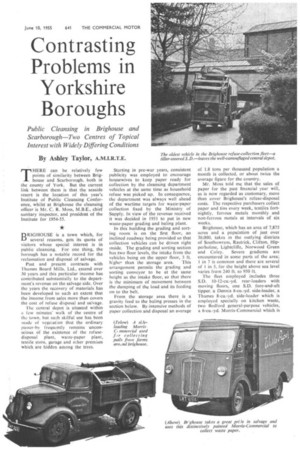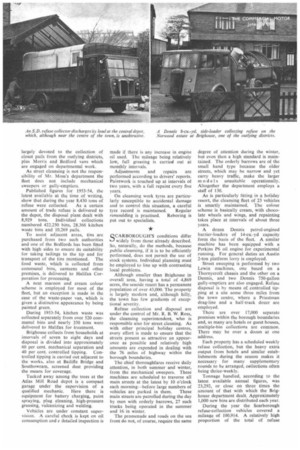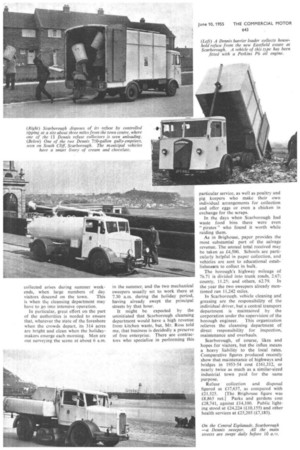Contrasting Problems in Yorkshire Boroughs
Page 75

Page 76

Page 77

If you've noticed an error in this article please click here to report it so we can fix it.
Public Cleansing in Brighouse and Scarborough—Two Centres of Topical Interest with Widely Differing Conditions
By Ashley Taylor, A.M.I.R.T.E.
THERE can be relatively few points of similarity between Brighouse and Scarborough. both in the county of York. But the current link between them is that the seaside resort is the location of this year's Institute of Public Cleansing Conference, whilst at Brighouse the cleansing officer is Mr. C. R. Moss, M.B.E., chief sanitary inspector, and president of the Institute for 1954-55.
El RIG HOUSE is a town which, for
several reasons, gets its quota of visitors whose special interest is in public cleansing. For one thing, the borough has a notable record for the reclamation and disposal of salvage.
Past and present contracts with Thames Board Mills, Ltd., extend over 30 years and this particular income has contributed substantially to the department's revenue on the salvage side. Over the years the recovery of materials has been developed to such an extent that the income from sales more than covers the cost of refuse disposal and salvage.
!he central depot is situated within few minutes' walk of the centre of the town, but such skilful use has been made of vegetation that the ordinary passer-by frequently remains unconscious of the existence of the refusedisposal plant, waste-paper plant, textile store, garage and other premises which are hidden among the trees. Starting in pre-war years, consistent publicity was employed to encourage housewives to keep paper ready for collection by the cleansing department vehicles at the same time as household refuse was picked up. In consequence, the department was always well ahead of the wartime targets for waste-paper collection fixed by the Ministry of Supply. In view of the revenue received it was decided in 1951 to put in new waste-paper grading and baling plant.
In this building the grading and sorting room is on the first floor, an inclined roadway being provided so that collection vehicles can be driven right inside. The grading and sorting section has two floor levels, the intake from the vehicles being on the upper floor, 3 ft.
highe, than the storage area. This arrangement permits the grading and sorting conveyor to be at the same height as the intake floor, so that there is the minimum of movement between the dumping of the load and its feeding on to the belt.
From the storage area there is a gravity feed to the baling presses in the section below. By,intensive methods of paper collection and disposal an average of 1.8 tons per thousand population a month is collected, or about twice the average figure for the country.
Mr. Moss told me that the sales of paper for the past financial year will, as is now regarded as customary, more than cover Brighouse's refuse-disposal costs. The respective purchasers collect paper and tins every week, textiles fortnightly, ferrous metals monthly and non-ferrous metals at intervals of six weeks.
Brighouse, which has an area of 7,875 acres and a population of just over 30.000, takes in the outlying districts of Southowram, Rastrick, Clifton, Hipperhohne, Lightelilfe, Norwood Green and Coley. Severe gradients are encountered in some parts of the area; 1 in 7 is common and there are several of 1 in 5, for the height above sea level varies from 240 ft. to 950 IL The fleet employed includes three S.D. 10-12-cu.-yd. rear-loaders with moving floors, one S.D. fore-and-aft tipper. a Dennis 8-cu.-yd. side-loader, a Thames 8-cu.-yd. side-loader which is employed specially on kitchen waste, two Bedford general-purpose vehicles, a 6-cu.-yd. Morris-Commercial which is
largely devoted to the collection of closet pails from the outlying districts, plus Morris and Bedford vans which are engaged on departmental work.
As street cleansing is not the responsibility of Mr. Moss's department the fleet does not include mechanical sweepers or gulIy-emptiers.
Published figures for 1953-54, the latest available at the time of writing, show that during the year 8,430 tons of refuse were collected. As a certain amount of trade refuse is delivered to the depot, the disposal plant dealt with 8,929 tons. Individual collections numbered 422.250 bins, 28,366 kitchen waste bins and 10,269 pails.
To assist adjacent areas, tins are purchased from two such authorities and one of the Bedfords has been fitted with high sides to ensure its suitability for taking tailings to the tip and for transport of the tins mentioned. The food waste, which is collected from communal bins, canteens and other premises, is delivered to Halifax Corporation for processing.
A neat maroon and cream colour scheme is employed for most of the fleet, but an exception is made in the case of the waste-paper van, which is given a distinctive appearance by being painted green.
During 1953-54, kitchen waste was collected separately from over 520 communal bins and nearly 350 tons were delivered to Halifax for treatment.
Brighouse collects from households at intervals of seven to eight days and disposal is divided into approximately 60 per cent. mechanical separation and 40 per cent, controlled tipping. Controlled tipping is carried out adjacent to the works, also at Bailiffe Bridge and Southowram, screened dust providing the means for coverage.
Tucked away among the trees at the Atlas Mill Road depot is a compact garage under the supervision of a qualified mechanic. Here there is equipment for battery charging, paint spraying, plug cleaning, high-pressure greasing, vulcanizing and welding.
Vehicles are under constant supervision. A careful cheek is kept on oil consumption and a detailed inspection is
made if there is any increase in engine oil used. The mileage being relatively low, full greasing is carried out at monthly intervals.
Adjustments and repairs are performed according to drivers' reports. Paintwork is touched up at intervals of two years, with a full repaint every five years.
On cleansing work tyres are particularly susceptible to accidental damage and to control this situation, a careful tyre record is maintained. Regular remoulding is practised. Reboring is put out to specialists.
SCARBOROUGH'S conditions differ widely from those already described. So, naturally, do the methods, because public cleansing, if it is to be efficiently performed, does not permit the use of stock systems, Individual planning must be employed to line up with contrasting local problems.
Although smaller than Brighouse in overall area, having a total of 4,869 acres, the seaside resort has a permanent population of over 43,000. The property is largely modern and, although hilly, the town has few gradients of exceptional severity.
Refuse collection and disposal are under the control of Mr. R. B. W. Ross, the cleansing superintendent, who is responsible also for street cleaning. As with other principal holiday centres, every effort is made to ensure that the streets present as attractive an appearance as possible and relatively high amounts are expended in dealing with the 76 miles of highway within the borough boundaries.
The chief thoroughfares receive daily attention, in both summer and winter, from the mechanical sweepers. These machines are scheduled to traverse all main streets at the latest by 10 o'clock each morning—before large numbers of vehicles are parked in them. These main streets are patrolled during the day by men with orderly barrows, 27 such trucks being operated in the summer and 16 in winter.
The promenade and roads on the sea front do not, of course, require the same degree of attention during the winter, but even then a high standard is maintained. The orderly barrows are of the small hand type because the older streets, which may he narrow and yet carry heavy traffic, make the larger models unsuitable operationally. Altogether the department employs a staff of 130.
As is particularly fitting in a holiday resort, the cleansing fleet of 23 vehicles is smartly maintained. The colour scheme is basically cream, with chocolate wheels and wings, and repainting takes place at intervals of about three years.
A dozen Dennis petrol-engined barrier-loaders of 14-cu.-yd capacity form the basis of the fleet. A similar machine has been equipped with a Perkins P6 oil engine for experimental running. For general duties an Austin 2-ton platform lorry is employed.
Street sweeping is performed by two Lewin machines, one based on a Thornycroft chassis and the other on a Dennis, and two Dennis 750-gallon gully-cmpliers are also engaged. Refuse disposal is by means of controlled tipping at a site some three miles from the town centre, where a Priestman drag-line and a half-track dozer are employed.
There are over 17,000 separate premises within the borough boundaries and, as many are hotels or guest houses, multiple-bin collections are common. There may be over a dozen at one address.
Each property has a scheduled weekly refuse collection, but the heavy extra output from hotels and similar establishments during the season makes it necessary for many supplementary rounds to be arranged, cellections often being thrice-weekly.
Tonnage handled, according to the latest available annual figures, was 23,292, or close on three times the amount of that with which the Brighouse department dealt. Approximately 1,000 new bins are distributed each year.
During the year the Scarborough refuse-collection vehicles covered a mileage of 100,914. A relatively high proportion of the total of refuse collected arises during summer weekends, when large numbers of day visitors descend on the town. This is when the cleansing department may have to go into intensive operation.
In particular, great effort on the part of the authorities is needed to ensure that, whatever the state of the foreshore when the crowds depart, its 314 acres arc bright and clean when the holidaymakers emerge each morning. Men are out surveying the scene at about 6 a.m. in the summer, and the two mechanical sweepers usually set to work there at 7.30 a.m. during the holiday period, having already swept the principal streets by that hour.
It might be expected by the uninitiated that Scarborough cleansing department would have a high revenue from kitchen waste, but, Mr. Ross told me, that business is decidedly a preserve of free enterprise. There are contractors who specialize in performing this particular service, as well as poultry and pig keepers who make their own individual arrangements for collection and offer eggs or even a chicken in exchange for the scraps.
In the days when Scarborough had waste food bins there were even " pirates" who found it worth while raiding them.
As in Brighouse, paper provides the most substantial part of the salvage revenue. The annual total received may be taken as 14,500. Schools are particularly helpful in paper collection, and vehicles are sent to educational establishments to collect in bulk.
The borough's highway mileage of 76.71 is divided into trunk roads, 2.67; county, 11.2.5; and others, 62.79. In the year the two sweepers already mentioned ran 11,242 miles.
In Scarborough. vehicle cleaning and greasing are the responsibility of the individual driver, but a central transport department is maintained by the corporation under the supervision of the borough engineer. This organization relieves the cleansing department of direct responsibility for inspection, maintenance and overhauls.
Scarborough, of course, likes and hopes for visitors, but the influx means a heavy liability to the local rates. Comparative figures produced recently show that maintenance of highways and bridges in 1953-54 cost £161,312, or nearly twice as much as a similar-sized industrial town paid for the same purpose.
Refuse collection and disposal figured at £37,637, as compared with £21,525. [The Brighouse figure was £8,865 net.] Parks and gardens cost £28,741, against £14,100. Public lighting stood at £24,224 (£10.155) and other health services at £25,205 (£7,185).




























































































































































